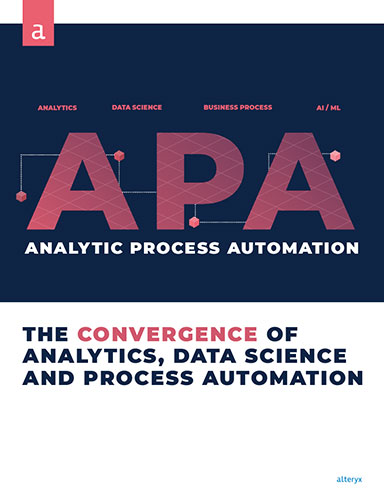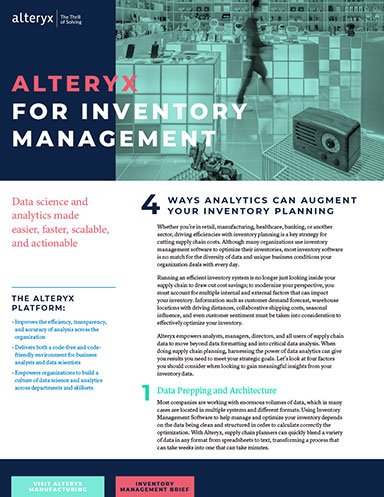Beyond COVID-19: How to Leverage AI and Analytics to Minimize “Supply Chain Disruption”

Today’s harsh reality is that supply chain practices in healthcare seriously lag those in other industries.
Supply Chain Disruption
The coronavirus (COVID-19) and the ensuing supply chain disruption has exposed weak links in the healthcare supply chain, and its implications for the health and safety of caregivers as well as patient outcomes.
However, spreadsheets are still the predominant supply chain planning and execution tool in use by analysts in healthcare around the world — despite its obvious limitations.
Can you afford to continue using static supply chain tools like spreadsheets and static weekly reports from your legacy ERP system to dynamically re-balance your supply chain and respond with the agility demanded in the event of another pandemic, epidemic, or disease outbreak?
It’s time for you to consider investing in next generation self-service AI + analytics platforms that will enable you to:
- Integrate, prep, and blend data from multiple healthcare IT (HIT) systems like ERP, EMR, Revenue Cycle Management (RCM), Procurement, etc., without having to hire a small army of consultants.
- Empower your supply chain analysts with accurate, reliable, and automated descriptive, spatial, predictive, and code-free visual analytics platforms and tools to enable them to accurately forecast and then position supply to respond to a rapidly changing landscape or disease outbreak?
- Empower your supply chain data scientists with code-friendly, self-service AI+ Analytics platforms that enable them to work with their machine learning and natural language processing (NLP) algorithms to enable robust scenario and strategic planning and what-if analysis?
- Empower your C-suite and line of business (LOB) leaders with accurate, reliable, and right time decision support, enabling actionable insights for them to make critical decisions that prevent supply chain disruption and minimize financial losses?
10 High-Value Artificial Intelligence (AI), Descriptive, Predictive, and Spatial Analytics-enabled use Cases to Minimize Supply Chain Disruption
Supply Chain Network Design
1. Utilize descriptive and spatial analytics-driven insights to locate your next hospital, testing center, or inventory locations (warehouses) based on provider/patient ratios, patient driving distance, socio-economic determinants of health etc., to maximize ROI on your investments and optimize for patient throughput and satisfaction.
Strategic Asset Utilization
2. Analyze the utilization of your most valuable assets like the ICU/ED, operating, and observation rooms (OR) based on patient flow, case mix variance, etc., and improve asset utilization to augment patient throughput, patient experience, and satisfaction (HCAHPS scores) along with hospital revenues and margins.
3. Repurpose and redeploy unused hospital beds for cardiovascular, oncology, etc., to ICU/ED beds equipped with ventilators and medical devices to cope with the surge of COVID-19 (and other epidemics and disease outbreaks) patients with serious life-threatening complications.
Strategic Sourcing
4. Utilize comprehensive spend analytics to identify your most important suppliers and developing strategic partnerships with them predicated on supply performance indicators, metrics, and KPIs for SLA compliance. This will also enable you to standardize on generics and lower-cost alternatives to expensive ethical drugs and potentially save millions in unnecessary spending.
5. Develop a risk-based analytics approach to sourcing from international/overseas suppliers based on distance, cost, and lead times and other relevant attributes and variables, and using spatial and predictive analytics to ensure that you are sourcing from the most dependable suppliers overseas who will respond timely during a crisis.
Demand Forecasting and Supply Planning
6. Predictive analytics-driven demand forecasting of drugs, devices, supplies, and emergency response inventory (ERI) like N-95 masks, gloves, gowns, PPE, testing kits, and ventilators for “business as usual” and emergency response triggered by an epidemic or disease outbreak.
7. Dynamic replanning of inventory (such as those listed above) on a daily (vs. weekly basis) based on advance just-in-time, demand flow, and other practices while ensuring the expired or about-to-expire drugs and devices are removed from the hospital supply to preclude risk of administration to patients. Some of these best practices are highlighted in the HBR article, “How Hospitals Can Manage Supply Shortages as Demand Surges.”
8. Collaborative forecasting, planning, and replenishment (CPFR) is a process in which your company not only collaborates and integrates planning, forecasting, and other data points from within your own organization but also uses data points provided by your suppliers and your customers. This is a best practice in the consumer packaged goods (CPG) and retail industries and has been deployed in the healthcare industry in countries like Taiwan that can be enabled with next-generation AI and analytics.
Procurement
9. Proactively detect and manage “maverick buying” (off-contract buying) and “price creep” happening in your hospitals. This practice is rampant and if proactively detected, can identify the SKUs (usually the most expensive drugs and devices ordered at inflated prices), and the employees responsible to minimize this wasteful and avoidable practice and save hospitals millions annually. Similarly, identifying “price creep” from your suppliers can save your organization hundreds of thousands of dollars each year with advanced analytics.
Continuous Improvement Enabled by Advanced Analytics
10. Utilize descriptive and predictive analytics and automated reporting and Lean Six-Sigma for continuous improvement of supply chain processes and metrics-driven performance. Manufacturing industries like automotive, hi-tech, CPG and consumer electronics have long adopted Lean Six-Sigma as a paradigm for continuous process improvement and augmentation of performance metrics and KPIs on an annual basis.
The key to enabling this is timely, accurate, reliable, and automated analytics and reporting as well as transparency. Advanced self-service AI and analytics platforms can enable this level of transparency, decision support, and automated reporting needed to enable a Lean Six-Sigma continuous process improvement culture in healthcare.
Related White Papers
The Essential Guide to Analytic Process Automation
With an Analytic Process Automation Platform, fast and efficient transformation is no longer a capital-intensive endeavor. Download Now!
4 Ways Analytics Can Augment Your Inventory Planning
While inventory management is complex, gathering, prepping, blending, analyzing, and auditing your data shouldn’t be. Download Now!
Article Topics
Alteryx News & Resources
Beyond COVID-19: How to Leverage AI and Analytics to Minimize “Supply Chain Disruption” Prepare Your Supply Chain for Uncertainty How to Change Your Supply Chain Inventory Planning Process 4 Ways Analytics can Augment Your Inventory Planning From COVID to Coca-Cola: Analyzing Distribution Models Create Predictive Models in Seconds for Faster and Better Forecasting Modern-Day Analytic Automation More AlteryxLatest in Technology
SAP Unveils New AI-Driven Supply Chain Innovations U.S. Manufacturing is Growing but Employment Not Keeping Pace The Two Most Important Factors in Last-Mile Delivery Spotlight Startup: Cart.com is Reimagining Logistics Walmart and Swisslog Expand Partnership with New Texas Facility Taking Stock of Today’s Robotics Market and What the Future Holds Biden Gives Samsung $6.4 Billion For Texas Semiconductor Plants More Technology















